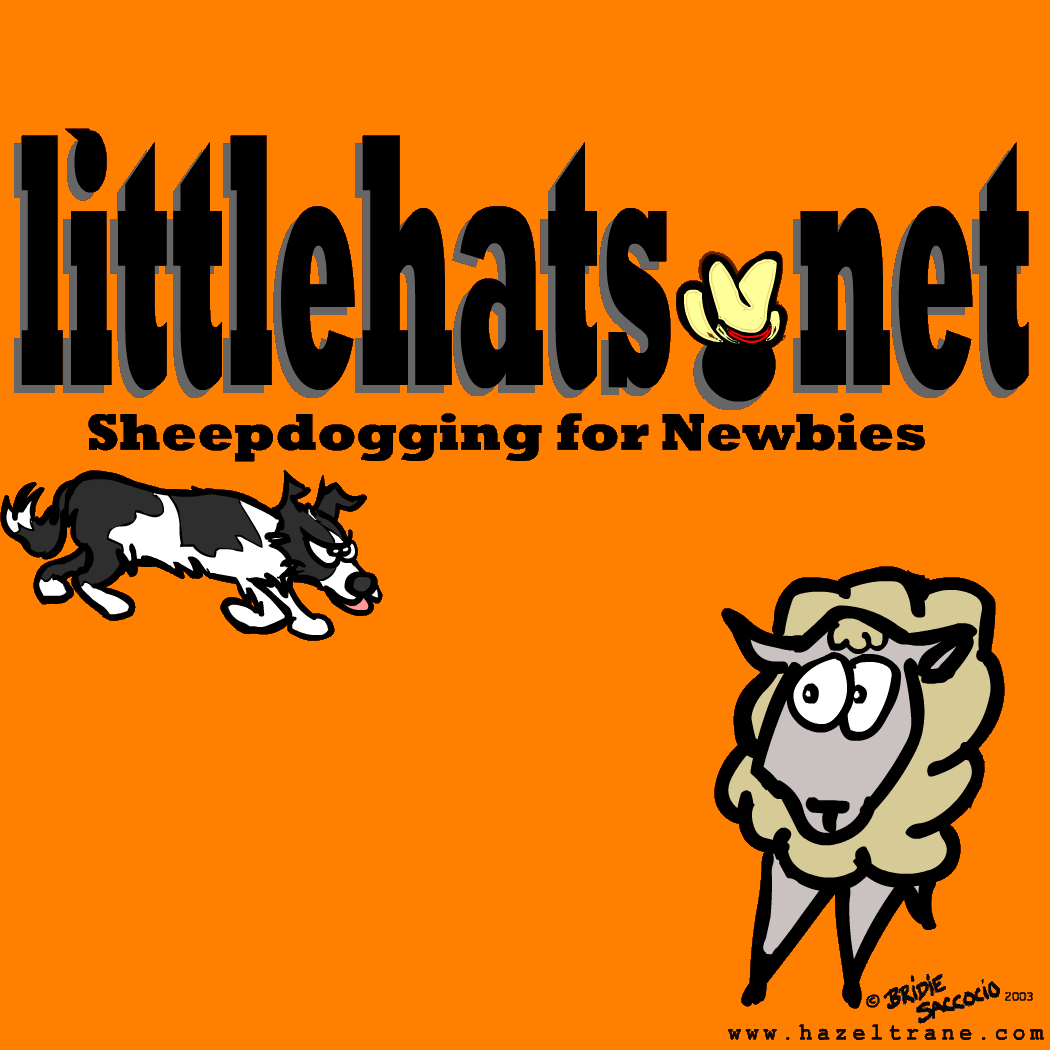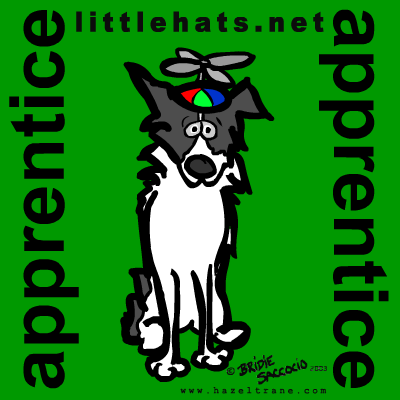


Outrun Questions
by Beverly Lambert
Search This Site
Originally Published in American Border Collie Magazine. Reprinted with permission.
This may seem like a silly question but how does the dog know the difference between when I send him on an outrun versus when I ask for a flank, like when driving? The commands are the same (away or come bye) but in the former the dog is supposed to go around the sheep and bring them to me and in the latter, he is supposed to go until I tell him to stop and then move them in a particular direction. The reason I ask is because I wonder if my dog is confused, when I send him on an outrun, since often he will stop part way out (like at about 3 o'clock) and start to walk in. Is there a way that the dog can or should know the difference? Or do I just need to reinforce the idea of going around the sheep unless I tell him to stop?
Actually there isn't really any difference between a flank and an outrun when we begin training. The early training for the outrun consists of sending the dog around a group of sheep that are standing next to the handler. The dog should run out around these sheep keeping far enough off so as not to disturb them until he reaches the balance point, where he should stop and balance. Certainly, as the dog's training advances and he is sent several hundred yards for his sheep, he begins to differentiate between this action and a simple flank, but the action remains pretty much the same.
There are certain sorts of default actions we build into the dogs as we train them. This is what we are doing with all of that early work, when we don't really seem to be teaching the dogs much of anything in particular. We are laying the groundwork for everything that follows. That groundwork is what the dogs should always fall back on if they don't know what else to do. One of these basic default actions is to bring the sheep to the handler. So all of the early work is the dog balancing sheep to the handler, and walking around fetching sheep to the handler as the handler backs away. A second default is that the dog should always move to the balance position on the stock. This is taught in much the same way as the fetch with the handler moving around and the dog finding the balance point. By the time a puppy has had a month of basic training he should, when released on a group of sheep, run around them until he finds the balance point, and then keep them up to the handler as the handler moves away. Once this is an automatic action on the part of the puppy, he can be sent greater and greater distances to get to the sheep, but he should always go out with the intention of getting to the balance point and bringing the stock to the handler.
When flanking, most dogs will either stop or hesitate at the balance point. I train my dogs on half flanks so all of their flanks are pretty short and small, unless I give them a really big flank command. The big or long flank command tells them to keep flanking until they hear a stop command; but even then, I will hit them with a second flank as they near the balance point just to tell them to carry on. That is because their default action, what they will do if they don't hear otherwise from me, would be to stop on the balance point and bring the sheep to me.
There could be several reasons why your dog is stopping short on the outrun. Since I can't see the dog, you will need to run some diagnostics and figure out the cause of the problem. First, determine if the dog is stopping on balance at the end of the outrun. When the dog stops and starts walking toward the sheep where do they go? If the sheep are really dog broke, a bit sour, and always run down the field to you as soon as they see the dog coming, this will make many dogs stop short. After all, we are dealing with a pretty smart dog, and it doesn't take long for it to figure out that it doesn't need to finish running around the sheep, if they are just going to run down the field any way. If this is the problem, you are going to need to find another way to work on your outrun. You can't keep sending a dog for sheep that don't respond rationally to the dog's actions without spoiling the dog. If the dog is lifting the sheep off line, not running to the balance point, test to see if the dog understands about going around the sheep. Put the sheep in the middle of the field, stand about 20 feet from them and send the dog around. Does the dog go to the balance point? If not then you need to work on reinforcing the dog's sense of balance.
If the dog passes both of these tests, then I would begin to think that you have a bit of an outrun training problem. I would use the second test at greater and greater distances, until I found how far the dog could run out correctly, and then work on lengthening the outrun gradually. A good, long outrun is taught up close and perfected at a distance. As soon as you see a problem at 200 or 600 yards, you need to pull the outrun in close and fix the problem, then go back to the distance to test the repair. You can't fix a problem that is occurring 300 yards away from you. A dog that makes a mistake at 300 yards will also almost certainly make the same mistake at 100 yards. It's just that the size of the mistake is directly related to the distance from the handler at which it occurs. This makes a mistake easy to see at 300 yards and perhaps very small and easy to miss at 50 yards.
Actually there isn't really any difference between a flank and an outrun when we begin training. The early training for the outrun consists of sending the dog around a group of sheep that are standing next to the handler. The dog should run out around these sheep keeping far enough off so as not to disturb them until he reaches the balance point, where he should stop and balance. Certainly, as the dog's training advances and he is sent several hundred yards for his sheep, he begins to differentiate between this action and a simple flank, but the action remains pretty much the same.
There are certain sorts of default actions we build into the dogs as we train them. This is what we are doing with all of that early work, when we don't really seem to be teaching the dogs much of anything in particular. We are laying the groundwork for everything that follows. That groundwork is what the dogs should always fall back on if they don't know what else to do. One of these basic default actions is to bring the sheep to the handler. So all of the early work is the dog balancing sheep to the handler, and walking around fetching sheep to the handler as the handler backs away. A second default is that the dog should always move to the balance position on the stock. This is taught in much the same way as the fetch with the handler moving around and the dog finding the balance point. By the time a puppy has had a month of basic training he should, when released on a group of sheep, run around them until he finds the balance point, and then keep them up to the handler as the handler moves away. Once this is an automatic action on the part of the puppy, he can be sent greater and greater distances to get to the sheep, but he should always go out with the intention of getting to the balance point and bringing the stock to the handler.
When flanking, most dogs will either stop or hesitate at the balance point. I train my dogs on half flanks so all of their flanks are pretty short and small, unless I give them a really big flank command. The big or long flank command tells them to keep flanking until they hear a stop command; but even then, I will hit them with a second flank as they near the balance point just to tell them to carry on. That is because their default action, what they will do if they don't hear otherwise from me, would be to stop on the balance point and bring the sheep to me.
There could be several reasons why your dog is stopping short on the outrun. Since I can't see the dog, you will need to run some diagnostics and figure out the cause of the problem. First, determine if the dog is stopping on balance at the end of the outrun. When the dog stops and starts walking toward the sheep where do they go? If the sheep are really dog broke, a bit sour, and always run down the field to you as soon as they see the dog coming, this will make many dogs stop short. After all, we are dealing with a pretty smart dog, and it doesn't take long for it to figure out that it doesn't need to finish running around the sheep, if they are just going to run down the field any way. If this is the problem, you are going to need to find another way to work on your outrun. You can't keep sending a dog for sheep that don't respond rationally to the dog's actions without spoiling the dog. If the dog is lifting the sheep off line, not running to the balance point, test to see if the dog understands about going around the sheep. Put the sheep in the middle of the field, stand about 20 feet from them and send the dog around. Does the dog go to the balance point? If not then you need to work on reinforcing the dog's sense of balance.
If the dog passes both of these tests, then I would begin to think that you have a bit of an outrun training problem. I would use the second test at greater and greater distances, until I found how far the dog could run out correctly, and then work on lengthening the outrun gradually. A good, long outrun is taught up close and perfected at a distance. As soon as you see a problem at 200 or 600 yards, you need to pull the outrun in close and fix the problem, then go back to the distance to test the repair. You can't fix a problem that is occurring 300 yards away from you. A dog that makes a mistake at 300 yards will also almost certainly make the same mistake at 100 yards. It's just that the size of the mistake is directly related to the distance from the handler at which it occurs. This makes a mistake easy to see at 300 yards and perhaps very small and easy to miss at 50 yards.